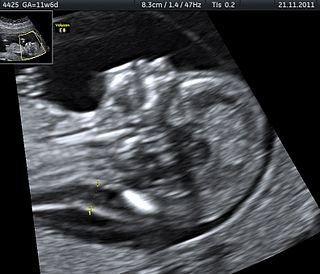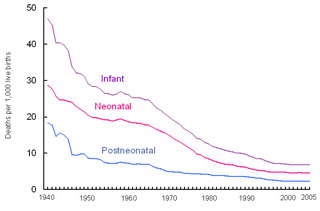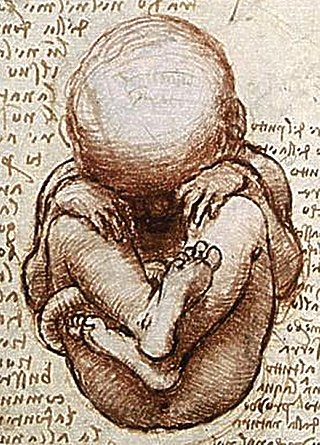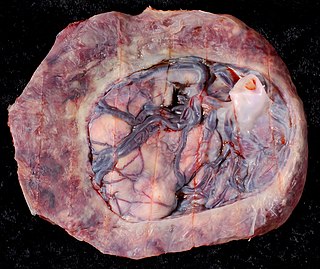Related Research Articles

Miscarriage, also known in medical terms as a spontaneous abortion, is the death and expulsion of an embryo or fetus before it is able to survive independently. The term miscarriage is sometimes used to refer to all forms of pregnancy loss and pregnancy with abortive outcome before 20 weeks of gestation.

In human reproduction, a live birth occurs when a fetus exits the mother showing any definite sign of life such as voluntary movement, heartbeat, or pulsation of the umbilical cord, for however brief a time and regardless of whether the umbilical cord or placenta are intact. After the fetus is expelled from the maternal body it is called a neonate. Whether the birth is vaginal or by Caesarean section, and whether the neonate is ultimately viable, is irrelevant.

Stillbirth is typically defined as fetal death at or after 20 or 28 weeks of pregnancy, depending on the source. It results in a baby born without signs of life. A stillbirth can often result in the feeling of guilt or grief in the mother. The term is in contrast to miscarriage, which is an early pregnancy loss, and Sudden Infant Death Syndrome, where the baby dies a short time after being born alive.

Obstetric ultrasonography, or prenatal ultrasound, is the use of medical ultrasonography in pregnancy, in which sound waves are used to create real-time visual images of the developing embryo or fetus in the uterus (womb). The procedure is a standard part of prenatal care in many countries, as it can provide a variety of information about the health of the mother, the timing and progress of the pregnancy, and the health and development of the embryo or fetus.

Pregnancy is the time during which one or more offspring develops (gestates) inside a woman's uterus (womb). A multiple pregnancy involves more than one offspring, such as with twins.
Prenatal development includes the development of the embryo and of the fetus during a viviparous animal's gestation. Prenatal development starts with fertilization, in the germinal stage of embryonic development, and continues in fetal development until birth.

Complications of pregnancy are health problems that are related to, or arise during pregnancy. Complications that occur primarily during childbirth are termed obstetric labor complications, and problems that occur primarily after childbirth are termed puerperal disorders. While some complications improve or are fully resolved after pregnancy, some may lead to lasting effects, morbidity, or in the most severe cases, maternal or fetal mortality.
In biology and medicine, gravidity and parity are the number of times a female has been pregnant (gravidity) and carried the pregnancies to a viable gestational age (parity). These two terms are usually coupled, sometimes with additional terms, to indicate more details of the female's obstetric history. When using these terms:

Perinatal mortality (PNM) is the death of a fetus or neonate and is the basis to calculate the perinatal mortality rate. Perinatal means "relating to the period starting a few weeks before birth and including the birth and a few weeks after birth."

Fetal movement refers to motion of a fetus caused by its own muscle activity. Locomotor activity begins during the late embryological stage and changes in nature throughout development. Muscles begin to move as soon as they are innervated. These first movements are not reflexive, but arise from self-generated nerve impulses originating in the spinal cord. As the nervous system matures, muscles can move in response to stimuli.
A fetus or foetus is the unborn offspring that develops from an animal embryo. Following embryonic development the fetal stage of development takes place. In human prenatal development, fetal development begins from the ninth week after fertilization and continues until birth. Prenatal development is a continuum, with no clear defining feature distinguishing an embryo from a fetus. However, a fetus is characterized by the presence of all the major body organs, though they will not yet be fully developed and functional and some not yet situated in their final anatomical location.

Circumvallate placenta is a rare condition affecting about 1-2% of pregnancies, in which the amnion and chorion fetal membranes essentially "double back" on the fetal side around the edges of the placenta. After delivery, a circumvallate placenta has a thick ring of membranes on its fetal surface. Circumvallate placenta is a placental morphological abnormality associated with increased fetal morbidity and mortality due to the restricted availability of nutrients and oxygen to the developing fetus.
Foeticide, or feticide, is the act of killing a fetus, or causing a miscarriage. Definitions differ between legal and medical applications, whereas in law, feticide frequently refers to a criminal offense, in medicine the term generally refers to a part of an abortion procedure in which a provider intentionally induces fetal demise to avoid the chance of an unintended live birth, or as a standalone procedure in the case of selective reduction.

Developmental toxicity is any developmental malformation that is caused by the toxicity of a chemical or pathogen. It is the structural or functional alteration, reversible or irreversible, which interferes with homeostasis, normal growth, differentiation, development or behavior. Developmental toxicity is caused by environmental insult, which includes drugs, alcohol, diet, toxic chemicals, and physical factors.
Definitions of abortion vary from one source to another. Abortion has many definitions that can differ from each other in significant ways. Given the contentious nature of abortion, lawmakers and other stakeholders often face controversy in defining abortion. Language referring to abortion often reflects societal and political opinions . Influential non-state actors like the United Nations and the Roman Catholic Church have also engendered controversy over efforts to define abortion.
Early pregnancy bleeding refers to vaginal bleeding before 14 weeks of gestational age. If the bleeding is significant, hemorrhagic shock may occur. Concern for shock is increased in those who have loss of consciousness, chest pain, shortness of breath, or shoulder pain.
Fetal resorption is the disintegration and assimilation of one or more fetuses in the uterus at any stage after the completion of organogenesis, which, in humans, is after the ninth week of gestation. Before organogenesis, the process is called embryo resorption. Resorption is more likely to happen early on in the gestation than later on; a later death of a fetus is likely to result in a miscarriage.
Pregnancy loss is the loss of an embryo or fetus. The terms early pregnancy loss and late pregnancy loss are often used but there is no consensus over their definitions.
Embryo loss is the death of an embryo at any stage of its development which in humans, is between the second through eighth week after fertilization. Failed development of an embryo often results in the disintegration and assimilation of its tissue in the uterus, known as embryo resorption. Loss during the stages of prenatal development after organogenesis of the fetus generally results in the similar process of fetal resorption or miscarriage. Embryo loss often happens without an awareness of pregnancy, and an estimated 40 to 60% of all embryos do not survive.
Reproductive loss, sometimes reproductive grief, describes a potential emotional response to unsuccessful attempts at human reproduction or family-building. These experienced losses may include involuntary childlessness generally, pregnancy loss from all causes, perinatal death, stillbirth, infecundity and infertility from all causes, failed attempts to conceive, failed fertility treatments, failed gestational surrogacy procedures, and losses related to all dimensions of the adoption process. Responses to miscarriage, stillbirth, selective reduction and neonatal death are a subtype of reproductive loss called perinatal bereavement.
References
- ↑ "Early Pregnancy Loss". American College of Obstetricians and Gynecologists: Practice Bulletin. November 2018. Retrieved 2023-04-22.
- ↑ staff, familydoctor org editorial (2022-05-20). "Early Pregnancy Loss". familydoctor.org. Retrieved 2023-10-06.
- ↑ "default - Stanford Medicine Children's Health". www.stanfordchildrens.org. Retrieved 2023-10-06.